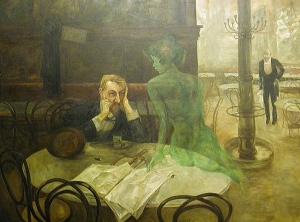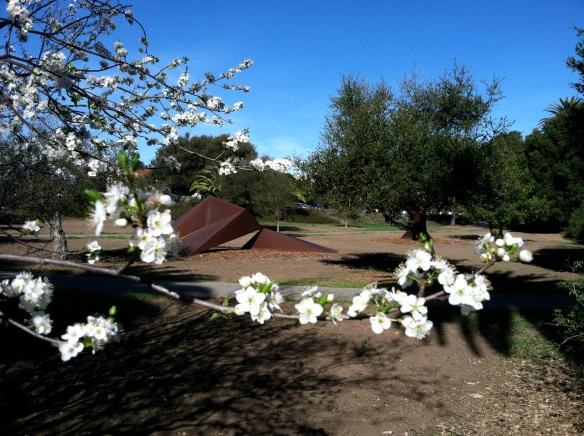Back in 2002 I went to Prague, where I was able to legally sample that storied vice of brooding 19th-century artists, absinthe. The preferred method of preparation was to pour some of the liquor into a large spoon, add a pinch of sugar, and heat it over a candle flame until the sugar dissolved. It was a ritual that added to the sense of participating in a dangerous, clandestine tradition, and coupled with the pre-Industrial-era architecture and cobblestone streets, I would leave the pub fully expecting to run into a Van Gogh-like figure, or at least hallucinate one.

"The absinthe drinker" being visited by the green fairy. By Czech painter Viktor Oliva, 1901.
Somewhat disappointingly, I never hallucinated any depressive one-eared artists. Or anything else for that matter. In fact, despite the 120-proof alcohol content, I only got modestly tipsy, thanks to the absinthe’s bitter, anise-y flavor (the origin for the word “absinthe” is likely the Greek apsinthion, which means “undrinkable”). The one time I followed the absinthe up with a couple glasses of red wine, I did end up with a headache that might have inspired some gruesomely morbid poetry, but I wasn’t feeling moved by a creative impulse so much as by the impulse to find out what had happened to my Advil over the course of 3 flights and two layovers.
Fast forward to this past St. Patrick’s Day, when my friends brought over a bottle of appropriately green absinthe made and sold just a few miles away at our local distillery, St. George’s. While the mystique was not so pronounced in my living room as it had been in a Czech pub, the product was definitely the same: the bottle confidently proclaimed that it contained extracts from wormwood (Artemisia absinthium, the plant that gives absinthe its distinctive flavor and color). Ten years ago, I had to go to Europe for this stuff. Why is it legal here now? Continue reading →





